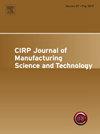Tolerance allocation by means of the polyhedral based tolerance analysis method
IF 5.4
2区 工程技术
Q2 ENGINEERING, MANUFACTURING
CIRP Journal of Manufacturing Science and Technology
Pub Date : 2025-05-27
DOI:10.1016/j.cirpj.2025.04.016
引用次数: 0
Abstract
The imperfection in the geometry and size of mechanical parts can lead to problems of assemblability and/or overall functionality. Defining acceptable tolerances for these imperfections is challenging because they impact how well the machine works and how much it costs to manufacture. In addition, tolerances for different parts often influence each other, contributing to a resultant tolerance.
This article presents a novel approach to tolerance allocation in mechanical design using the prismatic polyhedral approach and simulated annealing optimization. The prismatic polyhedral method effectively models deviations in complex mechanisms, while simulated annealing is used to optimize tolerance values considering both cost and functional compliance.
Methods based on sets of constraints, such as the prismatic polyhedral approach, can handle over- and iso-constrained mechanisms and, since it is feature based, it allows to model dependencies between rotational and translational deviations. However, they are often limited by high computational costs. To address this, the proposed methodology introduces a strategy to reduce the complexity of the contact graph reduction process, improving computational efficiency without sacrificing accuracy. Additionally, a new indicator of system compliance – the tolerance of circumscription – is introduced. This indicator has physical meaning and helps the designer to assess whether the system meets its functional conditions, as well as whether the total tolerance stack-up can be increased or needs to be tightened.
基于多面体的公差分析方法进行公差分配
机械零件的几何形状和尺寸上的缺陷可能导致可组装性和/或整体功能的问题。定义这些缺陷的可接受公差是具有挑战性的,因为它们会影响机器的工作性能和制造成本。此外,不同零件的公差通常会相互影响,从而形成最终的公差。本文提出了一种利用棱镜多面体方法和模拟退火优化方法进行机械设计公差分配的新方法。棱镜多面体方法可以有效地模拟复杂机构的偏差,而模拟退火方法可以同时考虑成本和功能顺应性来优化公差值。基于约束集的方法,如棱形多面体方法,可以处理超约束和等约束机制,并且由于它是基于特征的,它允许对旋转和动差之间的依赖关系进行建模。然而,它们通常受到高计算成本的限制。为了解决这个问题,提出的方法引入了一种策略来降低接触图约简过程的复杂性,在不牺牲精度的情况下提高计算效率。此外,还引入了一个新的系统遵从性指标-限制容忍度。该指标具有物理意义,可帮助设计人员评估系统是否满足其功能条件,以及是否可以增加总公差叠加或需要拧紧。
本文章由计算机程序翻译,如有差异,请以英文原文为准。
求助全文
约1分钟内获得全文
求助全文
来源期刊

CIRP Journal of Manufacturing Science and Technology
Engineering-Industrial and Manufacturing Engineering
CiteScore
9.10
自引率
6.20%
发文量
166
审稿时长
63 days
期刊介绍:
The CIRP Journal of Manufacturing Science and Technology (CIRP-JMST) publishes fundamental papers on manufacturing processes, production equipment and automation, product design, manufacturing systems and production organisations up to the level of the production networks, including all the related technical, human and economic factors. Preference is given to contributions describing research results whose feasibility has been demonstrated either in a laboratory or in the industrial praxis. Case studies and review papers on specific issues in manufacturing science and technology are equally encouraged.
 求助内容:
求助内容: 应助结果提醒方式:
应助结果提醒方式:


